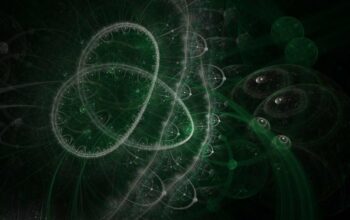In the realm of classical mechanics, the behavior of particles upon collision is well-documented and largely predictable. Yet, an enigmatic phenomenon emerges when these particles exhibit unexpected changes in direction—what one might term a “spin flip” during their interactions with boundaries or other particles. This article delves into the intricacies of such behavior, posing a provocative question: What underlying mechanics govern these spontaneous directional shifts, and can they be harnessed for innovative applications?
At the outset, it is crucial to delineate the context in which we consider bouncing particles. In a typical scenario, particles collide elastically with surfaces, causing them to reflect at angles corresponding to their incident trajectories. This phenomenon is governed by the law of reflection, which dictates that the angle of incidence equals the angle of reflection. However, when examining microscopic particles—such as atoms, molecules, or colloidal spheres—one often encounters behaviors that transcend classical predictions. The duality of wave-particle interactions brings forth quantum mechanics, which introduces uncertainty principles and probabilistic outcomes, thus complicating our understanding of particle trajectories.
Consider a gas composed of myriad particles colliding with one another. While one might anticipate their paths to be straightforward, the interactions can result in a variety of outcomes, including the seemingly erratic changes in direction that prompt the notion of a “spin flip.” Such occurrences may be attributed to several factors: inter-particulate forces, external fields, and the particle’s inherent properties. For instance, the introduction of an external magnetic field can cause charged particles to experience Lorentz forces, leading to curvilinear trajectories rather than linear reflections.
Moreover, the concept of “spin” itself warrants exploration. In quantum mechanics, particles such as electrons possess an intrinsic spin, a property that endows them with angular momentum even in the absence of physical rotation. This quantum characteristic influences not only the particle’s magnetic properties but also its interaction during collisions. When particles with different spins engage, they can exhibit remarkable behavior, including alterations in their angular momentum and trajectory, effectively prompting a spin flip. This complexity introduces new layers of unpredictability, as the outcome relies heavily on the spin states involved and their respective coupling during interactions.
Beyond individual particle interactions, one must also consider environmental factors that can induce unexpected deviations in particle direction. Thermal fluctuations, for instance, can impart sufficient energy to a system to overcome potential energy barriers, allowing particles to “surprisingly” change direction upon collision with a surface. This raises an intriguing inquiry about the role of entropy and chaotic behavior in non-equilibrium systems. The classic example of a bouncing ball elucidates this concept: while ideally one would expect it to follow a predictable path, factors such as surface irregularities and air resistance can obscure that predictability, yielding surprising outcomes.
With this backdrop established, it is pertinent to examine the implications of these unexpected directional changes. For instance, the deployment of particles in nanotechnology and material science could potentially benefit from harnessing these behaviors. Imagine designing nanocarriers for drug delivery systems that exploit spin flips to navigate complex biological environments. By engineering particles to respond to specific stimuli, it becomes conceivable to influence their trajectory and enhance the precision of therapeutic applications, ushering in novel paradigms in medicine.
Nonetheless, the prospect of manipulating such randomness presents challenges. The inherent unpredictability associated with quantum mechanics means that while theoretical models may suggest feasible paths for particle navigation, real-world applications may yield deviations. Thus, characterizing the probability distributions of these spin flips becomes paramount. Advanced computational simulations may elucidate the dynamics of particle behavior, representing a powerful tool for forecasting outcomes in experimental setups.
Furthermore, interdisciplinary research is crucial for bridging the gap between theory and application. Collaborations between physicists, chemists, and engineers will facilitate the development of innovative technologies that exploit the nuances of particle interactions. For instance, the synthesis of materials exhibiting tailored responses to external stimuli could pave the way for responsive systems, where the properties of materials shift based on environmental changes—an attribute that could revolutionize fields ranging from robotics to smart materials.
In conclusion, the phenomenon of spinning flips among bouncing particles presents both a captivating area of study and a potential challenge to harness in practical applications. The complexity of particle interactions—shaped by quantum mechanics, spins, and external influences—invites a more profound inquiry into the nature of unpredictability in physical systems. Fostering an understanding of these mechanisms could not only yield innovative technologies but also enhance existing theoretical models of particle dynamics, thus enriching our comprehension of the fundamental principles that govern the physical world. Amidst the nuanced dance of particles, the questions posed invite continued exploration and innovation, ensuring that science remains an ever-evolving and thrilling field.






